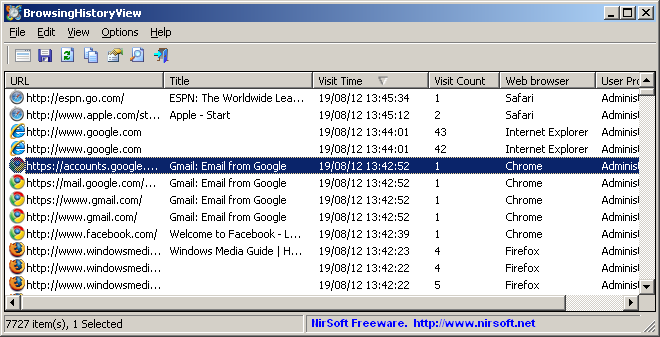|
|

Your download link is at the very bottom of the page... always. |
Processed through Paypal No account required. |
Buy our over-priced crap to help keep things running.










|
|

Your download link is at the very bottom of the page... always. |
Processed through Paypal No account required. |










| File - Download BrowsingHistoryView v2.41 | ||||||||
| Description | ||||||||
|
A plea... Deanna and I have been running this site since 2008 and lately we're seeing a big increase in users (and cost) but a decline in percentage of users who donate. Our ad-free and junkware-free download site only works if everyone chips in to offset the revenue that ads on other sites bring in. Please donate at the bottom of the page. Every little bit helps. Thank you so much. Sincerely, your Older Geeks: Randy and Deanna Always scroll to the bottom of the page for the main download link. We don't believe in fake/misleading download buttons and tricks. The link is always in the same place. BrowsingHistoryView v2.41 BrowsingHistoryView is a utility that reads the history data of 4 different Web browsers (Internet Explorer, Mozilla Firefox, Google Chrome, and Safari) and displays the browsing history of all these Web browsers in one table. The browsing history table includes the following information: Visited URL, Title, Visit Time, Visit Count, Web browser and User Profile. BrowsingHistoryView allows you to watch the browsing history of all user profiles in a running system, as well as to get the browsing history from external hard drive. You can also export the browsing history into csv/tab-delimited/html/xml file from the user interface, or from command-line, without displaying any user interface. This download is for the 64bit version. If you need the 32bit version, download here. Versions History Version 2.41: Fixed the /cfg command-line option to load the .cfg file from the current directory if full path is not specified. System Requirements This utility works on any version of Windows, starting from Windows 2000, and up to Windows 10. Both 32-bit and x64 systems are supported. The following Web browsers are supported: Internet Explorer (Version 4.00 and greater) Mozilla Firefox (Version 3.00 and greater) Microsoft Edge Google Chrome Safari Opera (Version 15 or later, which is based on Chrome Web browser) Known Limitations and Problems 'Visit Count' on Internet Explorer Web browser: The 'Visit Count' column is taken "as is" from the history file of Internet Explorer. Unfortunately, Internet Explorer tend to extremely bloat the 'Visit Count' number, which means that you cannot assume that the 'Visit Count' number represents the actual number of times that the user visited the specified Web site. This remark is only relevant for Internet Explorer. Other Web browsers count the number of visits properly, as far as I know. Limitations and problems with reading the history of IE10, IE11 and Microsoft Edge: Version 10 and 11 of Internet Explorer stores the history data inside WebCacheV01.dat, and this file is locked by the operating system most of the time, even when IE is closed. In order to unlock the history database file, you should turn on the 'Automatically stop the cache task of IE10/IE11/Edge' option. If you use the 'Load history from remote computer' option - BrowsingHistoryView will stop the cache task of IE10/IE11/Edge on the specified remote system, so you'll be able to see the history of IE10/IE11/Edge remotely. Start Using BrowsingHistoryView BrowsingHistoryView doesn't require any installation process or additional dll files. In order to start using it, simply run the executable file - BrowsingHistoryView.exe After you run BrowsingHistoryView, the 'Advanced Options' window is displayed. By default, BrowsingHistoryView offers you to load the history of all Web browsers and all user profiles in the last 10 days, but you can change the options according to your needs. After pressing 'Ok' in the 'Advanced Options' window, BrowsingHistoryView loads and displays the browsing history according to the options you chose. The 'Advanced Options' Window Filter by visit date/time: Allows you to load the history from the last number of days/hours, or from specific date/time range. Web Browsers: BrowsingHistoryView will load the history only from the selected Web browsers. For example, if you want to only get the browsing history of Internet Explorer, then you need to select the 'Internet Explorer' check-box and deselect all others. Load history from: Allows you to choose the data source of the browsing history: Load history from the current running system (All users): If you choose this option, BrowsingHistoryView scans all the user profiles on your system (C:\Documents and Settings or C:\Users) and loads the history data from them. Be aware that the Registry file of every user profile (NTUSER.DAT) should be readable, because BrowsingHistoryView uses the Registry file to locate the correct history file/folder of every Web browser. If BrowsingHistoryView cannot read NTUSER.DAT, it'll try to locate the correct folders in other less reliable ways. Load history from the current running system (Only current user): If you choose this option, BrowsingHistoryView loads only the browsing history of the current logged-on user. Load history from the specified profiles folder: If you choose this option, BrowsingHistoryView scans all the user profiles under the specified folder. The specified folder should be something like H:\Documents and Settings (On Windows XP) or H:\Users (On Windows 7/2008/Vista/8). Be aware that the Registry file of every user profile (NTUSER.DAT) should be readable, because BrowsingHistoryView uses the Registry file to locate the correct history file/folder of every Web browser. If BrowsingHistoryView cannot read NTUSER.DAT, it'll try to locate the correct folders in other less reliable ways. Load history from the specified profile: If you choose this option, BrowsingHistoryView loads the history from the specified profile folder. The specified profile folder should be something like H:\Documents and Settings\Administrator (On Windows XP) or H:\Users\Administrator (On Windows 7/2008/Vista/8). Reading History From Remote Computer If you have read access to the user profiles in another computer on your network, you can use BrowsingHistoryView to directly view the browsing history of the remote computer. However, due to the fact that the Registry file on the remote computer is probably locked, in some systems BrowsingHistoryView might fail to locate the correct history files or folders. In order to view the browsing history of all user profiles in a remote computer, use the 'Load history from the specified profiles folder' option, and then type the profiles folder on the remote computer, for example: \\192.168.0.10\c$\users In order to view the browsing history of a single user profile in a remote computer, use the 'Load history from the specified profile' option, and then type the profile folder on the remote computer, for example: \\192.168.0.10\c$\users\user01 Reading History From Shadow Copies If your hard drive has one or more shadow copies, you can view the history stored inside these shadow copies by selecting the 'Load history from the specified profiles folder' option in the 'Advanced Options' window and then choosing the desired shadow copy path (I'll be something like '\\?\GLOBALROOT\Device\HarddiskVolumeShadowCopy2\users') from the path combo-box. Inside shadow copies you may find old history items that don't exist in the current system as well as history items there were deleted by clearing the Web browser history. Be aware that the shadow copies feature only works starting from Windows Vista (XP is not supported). Command-Line Options /cfg <Filename> Start BrowsingHistoryView with the specified configuration file. For example: BrowsingHistoryView.exe /cfg "c:\config\bhv.cfg" BrowsingHistoryView.exe /cfg "%AppData%\BrowsingHistoryView.cfg" /stext <Filename> Save the browsing history into a regular text file. /stab <Filename> Save the browsing history into a tab-delimited text file. /scomma <Filename> Save the browsing history into a comma-delimited text file (csv). /stabular <Filename> Save the browsing history into a tabular text file. /shtml <Filename> Save the browsing history into HTML file (Horizontal). /sverhtml <Filename> Save the browsing history into HTML file (Vertical). /sxml <Filename> Save the browsing history into XML file. /sort <column> This command-line option can be used with other save options for sorting by the desired column. If you don't specify this option, the list is sorted according to the last sort that you made from the user interface. The <column> parameter can specify the column index (0 for the first column, 1 for the second column, and so on) or the name of the column, like "Title" and "URL". You can specify the '~' prefix character (e.g: "~Visit Time") if you want to sort in descending order. You can put multiple /sort in the command-line if you want to sort by multiple columns. Examples: BrowsingHistoryView.exe /shtml "f:\temp\history.html" /sort 2 /sort ~1 BrowsingHistoryView.exe /shtml "f:\temp\history.html" /sort "URL" /sort "Visit Time" /nosort When you specify this command-line option, the list will be saved without any sorting. /SaveDirect Save the browsing history in SaveDirect mode. For using with the other save command-line options ( /scomma, /stab, /sxml, and so on...) When you use the SaveDirect mode, the history lines are saved directly to the disk, without loading them into the memory first. This means that you can save a list with large amount of history lines into your disk without any memory problem, as long as you have enough disk space to store the saved file. The drawback of this mode: You cannot sort the lines according to the column you choose with /sort command-line option. /HistorySource <Source> Specifies the type of history data source: 1 - Load history from the current running system (All users). 2 - Load history from the current running system (Only current user). 3 - Load history from the specified profiles folder (/HistorySourceFolder command-line parameter). 4 - Load history from the specified profile (/HistorySourceFolder command-line parameter). /HistorySourceFolder <Folder> Specifies the folder path if /HistorySource is 3 or 4. /VisitTimeFilterType <Filter Type> Specifies the type of date/time filter: 1 - Load history from any date/time. 2 - Load history from the last xx hours (xx specified in /VisitTimeFilterValue) 3 - Load history from the last xx days (xx specified in /VisitTimeFilterValue) 4 - Load history from the specified date/time range (The time range is specified in /VisitTimeFrom and /VisitTimeTo) /VisitTimeFilterValue <Filter Value> Specifies the filter value when /VisitTimeFilterType is 2 or 3 /VisitTimeFrom <Time> /VisitTimeTo <Time> Specifies the date/time range when /VisitTimeFilterType is 4. date/time value must be in the following format: dd-mm-yyyy hh:nn:ss For example: BrowsingHistoryView.exe /VisitTimeFrom "10-01-2012 12:00:00" /VisitTimeTo "18-02-2012 10:00:00" /LoadIE <0 | 1> /LoadFirefox <0 | 1> /LoadChrome <0 | 1> /LoadSafari <0 | 1> Specifies whether to load the history of IE/Firefox/Chrome/Safari Web browser. 0 = Don't load, 1 = Load. Here's some command-line examples: BrowsingHistoryView.exe /HistorySource 4 /HistorySourceFolder "H:\Documents and Settings\User01" /stab "c:\temp\history.txt" BrowsingHistoryView.exe /HistorySource 3 /HistorySourceFolder "G:\Documents and Settings" /VisitTimeFilterType 3 /VisitTimeFilterValue 10 /scomma "c:\temp\history.csv" BrowsingHistoryView.exe /HistorySource 1 /LoadIE 1 /LoadFirefox 0 /LoadChrome 0 /LoadSafari 0 /shtml "c:\temp\history.html" BrowsingHistoryView.exe /HistorySource 2 /VisitTimeFilterType 4 /VisitTimeFrom "01-01-2011 00:00:00" /VisitTimeTo "01-01-2012 00:00:00" /stab "c:\temp\history.txt" Translating BrowsingHistoryView to other languages In order to translate BrowsingHistoryView to other language, follow the instructions below: Run BrowsingHistoryView with /savelangfile parameter: BrowsingHistoryView.exe /savelangfile A file named BrowsingHistoryView_lng.ini will be created in the folder of BrowsingHistoryView utility. Open the created language file in Notepad or in any other text editor. Translate all string entries to the desired language. Optionally, you can also add your name and/or a link to your Web site. (TranslatorName and TranslatorURL values) If you add this information, it'll be used in the 'About' window. After you finish the translation, Run BrowsingHistoryView, and all translated strings will be loaded from the language file. If you want to run BrowsingHistoryView without the translation, simply rename the language file, or move it to another folder. License This utility is released as freeware. You are allowed to freely distribute this utility via floppy disk, CD-ROM, Internet, or in any other way, as long as you don't charge anything for this and you don't sell it or distribute it as a part of commercial product. If you distribute this utility, you must include all files in the distribution package, without any modification ! Disclaimer The software is provided "AS IS" without any warranty, either expressed or implied, including, but not limited to, the implied warranties of merchantability and fitness for a particular purpose. The author will not be liable for any special, incidental, consequential or indirect damages due to loss of data or any other reason. Feedback If you have any problem, suggestion, comment, or you found a bug in my utility, you can send a message to nirsofer@yahoo.com  Click here to visit the author's website. Continue below for the main download link. |
||||||||
| Downloads | Views | Developer | Last Update | Version | Size | Type | Rank | |
| 6,457 | 16,051 | Nir Sofer <img src="https://www.oldergeeks.com/downloads/gallery/thumbs/browsinghistoryview_th.png"border="0"> | Jul 20, 2020 - 11:07 | 2.41 | 293.9KB | ZIP |  , out of 73 Votes. , out of 73 Votes. |
|
| File Tags | ||||||||
| BrowsingHistoryView v2.41 | ||||||||
|
Click to Rate File Share it on Twitter → Tweet
|